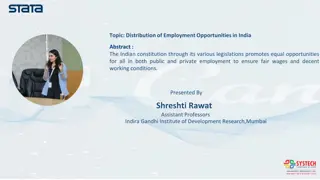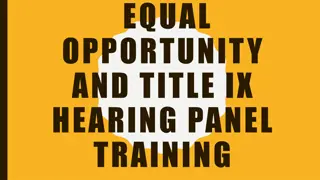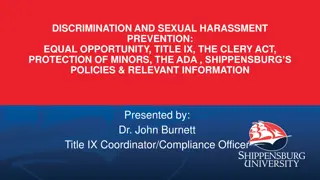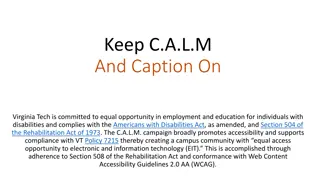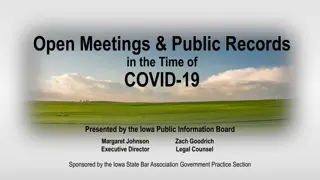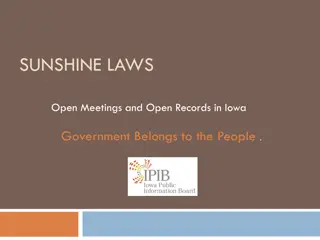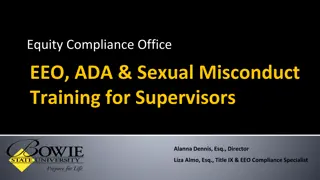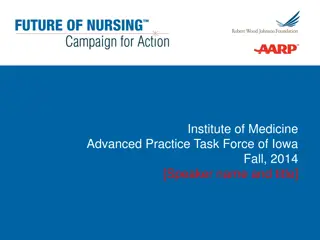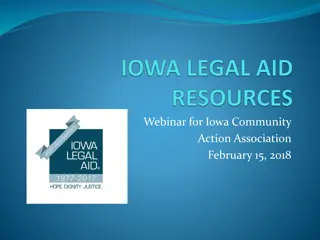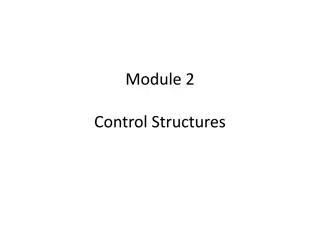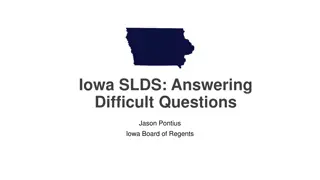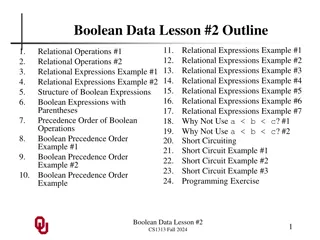Understanding Title IX: Office of Equal Opportunity Training at Iowa State University
Explore key aspects of Title IX, including scope, jurisdiction, and application to sexual harassment in educational settings. Learn about the responsibilities of entities receiving federal financial assistance and the protections provided by Title IX for individuals within the U.S. Discover how educational institutions handle formal complaints, investigations, hearings, appeals, and informal resolutions related to sexual harassment. Gain insights into the importance of confidentiality in maintaining a safe and inclusive environment.
Download Presentation

Please find below an Image/Link to download the presentation.
The content on the website is provided AS IS for your information and personal use only. It may not be sold, licensed, or shared on other websites without obtaining consent from the author. Download presentation by click this link. If you encounter any issues during the download, it is possible that the publisher has removed the file from their server.
E N D
Presentation Transcript
Office of Equal Opportunity Title IX and Sexual Harassment Response Training for Iowa State University Title IX Personnel Presented by Title IX Coordinator Dr. Adrienne Lyles December 17 and 18, 2020
AGENDA Title IX Scope & Jurisdiction Title IX & Other Policies Institutional Response to Sexual Harassment Formal Complaints Investigations Hearings Appeals Informal Resolution Confidentiality Office of Equal Opportunity
Office of Equal Opportunity Title IX Scope and Jurisdiction
What is Title IX [N]o person in the United States shall on the basis of sex be excluded from participation in, be denied the benefits of, or be subjected to discrimination under any education program or activity receiving federal financial assistance. 32 C.F.R. 106.31 Office of Equal Opportunity
Who does Title IX apply to? Entities that receive federal financial assistance, including colleges and universities that participate in Title IV funding Not individual persons But institutions are required to adopt policies and procedures to implement Title IX that do apply to individual persons Office of Equal Opportunity
What sexual harassment does Title IX apply to? Title IX applies to sexual harassment in the education program or activity of a federal funding recipient Title IX defines education program or activity to include the operations of educational institutions Does apply to conduct occurring in property owned or controlled by an officially-recognized student organization Does not apply to private conduct occurring in private location that is not part of education program/activity Office of Equal Opportunity
Title IX application Education program or activity Current student or employee or individual attempting to participate Within geographic boundaries of U.S. Effective August 14, 2020 Office of Equal Opportunity
Examples of education programs & activities Admissions Academic Instruction Workplace Sports Teams Residence Life Hiring Sponsored Activities Campus amenities Work-Study Off-Campus Experiences Organized by the Institution Games, Concerts, Speeches On-Campus Anything Else that Happens On-Campus Office of Equal Opportunity
Does Title IX apply to off-campus sexual harassment?? Yes, if the conduct at issue occurs in the context of an education program or activity Yes, if the conduct at issue occurs in a house owned or controlled by an officially-recognized Greek organization or other student organization No, if the conduct occurs in a private location and is not part of an institution s education program or activity Office of Equal Opportunity
Examples of education program/activity The tennis team travels to a different school for a tournament and stays overnight at a hotel. At the hotel where the team is staying, the coach sexually harasses the team s manager. Student is sexually assaulted in a residence hall on-campus. The sexual assault occurs on a Saturday evening. The identity of the perpetrator is not immediately known. During spring break, two students travel to another state and stay at a resort owned by a hotel chain. The students booked the trip on their own for leisure purposes. While staying at the resort, one student sexually assaults the other student. Office of Equal Opportunity
Does Title IX apply to sexual harassment in other countries? No the Department of Education interprets Title IX to apply only within the geographic boundaries of the U.S. Other countries may have laws that govern sexual harassment Office of Equal Opportunity
What is Title IX Sexual Harassment? Conduct on the basis of sex that is: Quid pro quo harassment by employee Hostile environment harassment Sexual assault Dating violence Domestic violence Stalking Office of Equal Opportunity
Quid pro quo harassment An employee of the institution conditions the provision of some aid, benefit, or service on another person s participation in unwelcome sexual conduct. Often arises where employee holds position of authority over a student. Office of Equal Opportunity
Examples of quid pro quo Manager tells employee that employee will not get a raise this year unless they perform sexual favors for manager. Employee has no interest in performing sexual favors for manager. Faculty member tells student that student can increase their grade from a B to an A if the student wears revealing clothing that is more pleasing to the faculty member s eye. Office of Equal Opportunity
Hostile environment sexual harassment Unwelcome conduct determined by a reasonable person to be so severe, pervasive, and objectively offensive that it effectively denies a person equal access to the recipient s education program or activity. Look at: Type of misconduct Frequency Where misconduct occurred Power differentials? Office of Equal Opportunity
How do we determine if a hostile environment exists? 1. Consider all the facts and circumstances, such as: The type of misconduct The frequency of the misconduct Where the misconduct occurs Whether a power differential exists, etc. 2. From the perspective of a reasonable person Office of Equal Opportunity
Example of hostile environment Student A repeatedly gropes Student B s buttocks when the two are in the elevator of their shared dormitory. B has no romantic interest in A and has told A to stop. But A persists, causing B to use the stairs instead of the elevator and to avoid A in other areas of the dormitory. Office of Equal Opportunity
Another example of hostile environment Student A asks Student B to go on a date, and B says no. A then repeatedly sends B text messages using various vulgar terms that suggest that B is promiscuous. When Student A and Student B attend a shared biology class, A mutters these vulgar terms toward B, loud enough for others to hear. Student B blocks Student A s phone number and drops the biology class to avoid Student A. Office of Equal Opportunity
Another example of hostile environment Student A obtains a nude picture of Student B from B s former romantic partner. Student A threatens to post the nude picture on social media unless Student B poses nude for A in A s dorm room. Student B poses for Student A to avoid the nude picture being circulated. Student A is not an employee. Office of Equal Opportunity
Example of not hostile environment Student A actively supports a prominent political candidate who has been accused of sexually harassing campaign staffers. Student B files a complaint that Student A s political support of the candidate has caused a sexually hostile environment on campus. Office of Equal Opportunity
First Amendment considerations Sexual harassment under Title IX does not include conduct that is protected by the First Amendment. The subjective offensiveness of speech, alone, is not sufficient to create a hostile environment. Office of Equal Opportunity
Next we are going to discuss sexual assault: Rape Sodomy Sexual assault with an object Fondling Incest Statutory Rape Domestic Violence Dating Violence Stalking We will start with discussion of consent & capacity Office of Equal Opportunity
Consent: ISU Title IX Policy An informed, voluntary, and active agreement expressed through affirmative words or actions, and mutually understandable to all parties involved, to engage in a specific sexual act at a specific time. Look at: Presence of force, threat of force, intimidation, coercion? Did complainant have the capacity to give consent? Would the communication between the parties be interpreted by a reasonable person (under similar circumstances and with similar identities) as a willingness to engage in a specific sexual act? Office of Equal Opportunity
Incapacity Incapacity refers to a state where a person does not appreciate the nature or fact of sexual activity due to the effect of drugs or alcohol consumption, medical condition or disability, or due to a state of unconsciousness or sleep. Office of Equal Opportunity
Example of incapacitation Student A has had ten cocktails over the course of two hours. Student B takes Student A to Student B s apartment. Student A cannot walk without support, forgets B s name, and passes into a stupor when B places A on B s bed. Student B then has sex with Student A. Office of Equal Opportunity
Example of not incapacitated Student A has had four beers over the course of two hours. Student A calls Student B to see if Student B is home. A then drives from campus to B s off-campus apartment. Upon arriving, Student A initiates sexual contact with Student B, and then insists that B use contraception before the two have intercourse. Student A is an active participant in the intercourse. Next we will discuss sexual assault. Office of Equal Opportunity
What is sexual assault? Under Title IX, sexual assault incorporates the following classes of conduct: Rape Sexual assault with an object Sodomy Fondling Incest Office of Equal Opportunity
What is rape? Having carnal knowledge of a person, without the consent of the victim, including instances where the victim is incapable of giving consent because of age or because of temporary or permanent mental or physical incapacity. There is carnal knowledge if there is the slightest penetration of the vagina or penis by the sex organ of the other person. Attempted rape is included. Office of Equal Opportunity
What is sodomy? Oral or anal sexual intercourse with another person without the consent of the victim, including instances where the victim is incapable of giving consent because of age or because of temporary or permanent mental or physical incapacity. Office of Equal Opportunity
What is sexual assault with an object? Using an object or instrument to unlawfully penetrate, however slightly, the genital or anal opening of the body of another person, without the consent of the victim, including instances where the victim is incapable of giving consent because of age or because of temporary or permanent mental or physical incapacity. An object or instrument is anything used by the perpetrator other than the perpetrator s genitalia. Office of Equal Opportunity
What is fondling? Touching of the private body parts of another person for the purpose of sexual gratification, without the consent of the victim, including instances where the victim is incapable of giving consent because of age or because of temporary or permanent mental or physical incapacity. Office of Equal Opportunity
Example of fondling Student A and Student B attend a dance held in the student union. While on the dance floor, Student A gropes Student B s groin without B s permission. Student B does not welcome the groping and views it as unwelcome. Office of Equal Opportunity
What is incest? Sexual intercourse between persons who are related to each other within the degrees wherein marriage is prohibited by law. Office of Equal Opportunity
What is statutory rape? Sexual intercourse with a person who is under the statutory age of consent as defined by law. Office of Equal Opportunity
What is domestic violence? Felony or misdemeanor crimes of violence committed by a current or former spouse or intimate partner of the victim, by a person with whom the victim shares a child in common, by a person who is cohabitating with or has cohabitated with the victim as a spouse or intimate partner, by a person similarly situated to a spouse of the victim under the domestic or family violence laws of the state, or by any other person against an adult or youth victim who is protected from that person s acts under the domestic or family violence laws of the state. Office of Equal Opportunity
What is dating violence? Dating Violence is violence committed by a person: Who is or has been in a social relationship of a romantic or intimate nature with the victim; and Where the existence of such a relationship will be determined based on consideration of the following factors: The length of the relationship; The type of relationship; and The frequency of interaction between the persons involved in the relationship. Office of Equal Opportunity
Example of dating violence Employee A and Employee B are engaged to be married but live separately and have no children in common. A and B get into an argument in A s car in the university s parking lot. During the argument, Employee A slaps Employee s B s face and tells B to shut your mouth. Office of Equal Opportunity
What is stalking? Engaging in a course of conduct directed at a specific person that would cause a reasonable person to: Fear for their safety or the safety of others; or Suffer substantial emotional distress. Office of Equal Opportunity
Example of stalking Student A is infatuated with Student B, who has rebuffed Student A s romantic advances. Thereafter, Student A dresses in black and sneaks up to the window of B s Greek house at night in an attempt to see B. Student A does this twice before being caught in the act during A s third attempt. Office of Equal Opportunity
Title IX also prohibits retaliation Title IX prohibits intimidation, threats, coercion, or discrimination against any individual for the purpose of interfering with any right or privilege secured by Title IX and its implementing regulations or because an individual has made a report or complaint, testified, assisted, participated in or refused to participate in any manner in an investigation, proceeding, or hearing under the institution s policy. Office of Equal Opportunity
Example of retaliation Employee A testifies at hearing in support of Employee B s complaint of sexual harassment against manager. After institution finds that manager sexually harassed Employee B, manager demotes Employee A to punish A for testifying against manager. Office of Equal Opportunity
What about state laws governing sexual harassment on campus? Institutions must still comply with state laws unless: They conflict with some element of the new Title IX regulation, in which case State law is preempted Office of Equal Opportunity
GROUP SCENARIO Student A reports that Student B sexually harassed Student A on two occasions. The first incident consisted of B groping A s genitals without permission while the two were dancing during a formal hosted by a Greek organization at a local party venue the Greek organization rented. The second incident consisted of Student B attempting to have sexual intercourse with Student A one week later, when A was heavily intoxicated at a tailgate party held in the parking lot of a rival institution s football stadium. Office of Equal Opportunity
Office of Equal Opportunity Title IX and Other Policies
Examples of Policies with Related Concepts Discrimination Relationships Consenting Relationships Title IX Non-Discrimination and Anti- Harassment Conduct Student Code of Conduct Faculty Handbook Reporting Responsibility Violations Code of Business & Fiduciary Conduct Uniform Rules of Personal Conduct Discipline Summary Dismissal P&S Office of Equal Opportunity
ISU policies/codes/handbooks Institutions are free to use other policies to address Sexual Harassment that does not occur in an education program/activity. Students Employees Title IX Policy Anti-Discrimination and Non-Harassment Policy Consenting Relationships Policy Reporting Responsibility Violations Code of Business & Fiduciary Conduct Uniform Rules of Personal Conduct Non-Retaliation Against Persons Reporting Misconduct Faculty Handbook Grievance Management Merit Statement on Ethics P&S Summary Dismissal P&S Dispute Resolution P&S Prohibited Title IX Sexual Harassment, Sexual Assault, Dating Violence, Domestic Violence, and Stalking Policy Student Code of Conduct Graduate College Handbook Non-Retaliation Against Persons Reporting Misconduct Office of Equal Opportunity
Comparing Title IX and Title VII Neither Federal non-sex discrimination civil rights law represents a zero tolerance policy banning all sexual harassment. Preamble to 2020 Title IX Regulations Title IX Sexual Harassment Title VII Sexual Harassment Any quid pro quo by Employee Unwelcome and sufficiently severe and pervasive and objectively offensive Any sexual assault/DV/s talking Quid pro quo Sufficiently severe or pervasive Office of Equal Opportunity
How should we treat alleged conduct that may violate Title IX and Title VII policies? The Department recognizes that employers must fulfill their obligations under Title VII and also under Title IX. There is no inherent conflict between Title VII and Title IX, and the Department will construe Title IX and its implementing regulations in a manner to avoid an actual conflict between an employer s obligations under Title VII and Title IX. Preamble to 2020 Title IX Regulations (also 34 C.F.R. 106.6(f)) Office of Equal Opportunity
Example of typical Title VII process Complaint to manager, HR, ethics line, etc. HR/manager collaborate to provide information to parties, investigate, and resolve HR/manager take any appropriate corrective and preventive action, and protect against retaliation Office of Equal Opportunity
What triggers an employers liability for sexual harassment under Title VII? 1. An employer, its agent, or its supervisor 2. Knew or should have known 3. About severe or pervasive sexual harassment 4. That a reasonable person would consider intimidating, hostile, or abusive 5. By an employee or non-employee over which it has control, and 6. Failed to take appropriate corrective action U.S. Equal Employment Opportunity Commission, Harassment (https://www.eeoc.gov/harassment) Office of Equal Opportunity



